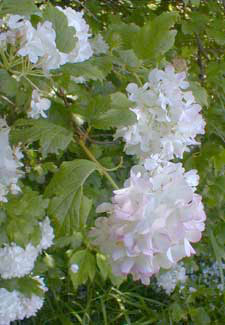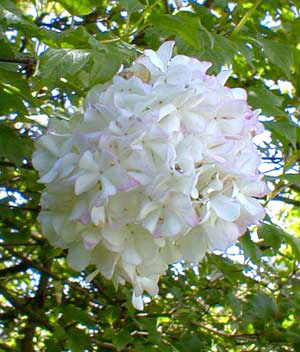
Snowball Viburnum
"And, tossed beside the Guelder rose,
A heap of rainbow knitting,
Where, blinking in her pleased repose,
A Persian cat was sitting."
-Austin Dobson
(1840-1921)
(1840-1921)
A very short walk down the road from our house, there is a very old & large Viburnum opulus var sterile 'Roseum.' This is the European snowball bush, snowball tree, or Guelder Rose, the latter name after Gelderland, The Netherlands.
 The species is also known as the Dog Rowan, European Highbush Cranberry (though 'Roseum' does not set fruit), Whitsun Bosses or Whitsun Rose, May Rose, Rose Elder, Water Elder, Cramp Bark (from a traditional medicinal use), King's Crown, or Silver Bells. It is a deciduous shrub of ten or twelve feet height with equal width, & sometimes gets larger.
The species is also known as the Dog Rowan, European Highbush Cranberry (though 'Roseum' does not set fruit), Whitsun Bosses or Whitsun Rose, May Rose, Rose Elder, Water Elder, Cramp Bark (from a traditional medicinal use), King's Crown, or Silver Bells. It is a deciduous shrub of ten or twelve feet height with equal width, & sometimes gets larger.'Roseum' is an heirloom shrub gardened since the 16th Century. Ordinary V. opulus has lace-cap flowers, a circle of large sterile flowers surrounding miniscule fertile flowers. But 'Roseum' has only the large sterile flowers, which results in a big round three-inch pompom.
The drawback of this cultivar's amazing double-flower is it does not set cranberries. The regular lacecap is additionally desireable not only for its own beauty, but for the addition of fruits so bitter the birds will leave them for their color & ornamental value right up to winter. Nevertheless, the startling size of the snowball flower has rendered it for centuries a most popular shrub.
Its maple-like leaves are a soft green, with good autumn color in the orange-red range, brighter than is usually true of the regular shrub, a condition which helps make up for the lack of decorative berries.
It blooms in May. Although the flowers start out pure white, they become flushed with pink as they are fading, as can be seen in the photo above of fading pompoms. This unusual feature lends the shrub the cultivar name 'Roseum.' But because the name often leads to the unfillable expectation of outright pink flowers, it is often sold as 'Sterile' or 'Snowball.'
It does well in sun or partial shade & is cold-hardy to Zone 4. It likes humus-rich, moist, well draining soil. It is generally disease-free, the exceptions being its attractiveness to aphids, & susceptibility to powdery mildew if planted in crowded conditions or muggy climates.
A small start can take four years to begin to be substantial & to flower, but once it has at long last gotten well established & finally starts growing, it will have rapid growth thereafter, & will quickly bounce back from even a hard pruning.
There are other Snowball viburnum species, including V. plicatum snowball form of the Doublefile Viburnum, V. macrocephalum or Chinese Viburnum, & V. carlcephalum or Fragrant Snowball.